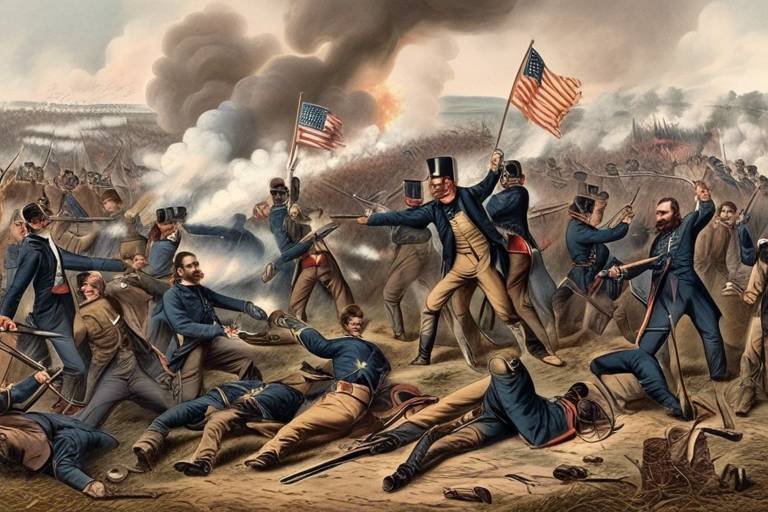The Role of Indigenous Peoples in American History
Indigenous peoples have played a crucial role in shaping the history of America, their contributions, struggles, and cultural impact reverberating through the ages. Before the arrival of European settlers, North America was home to a myriad of rich and diverse civilizations, each with its own social structures, technologies, and ways of life.
As colonial encounters unfolded, the relationships between indigenous tribes and early European colonizers grew complex. Trade, conflict, and cultural exchange characterized this period, leaving a lasting imprint on both indigenous communities and the settlers.
The Trail of Tears stands as a stark reminder of the forced relocation of Native American tribes, notably the Cherokee, from their ancestral lands to designated territories in the 19th century. The profound impact of this tragic event continues to shape indigenous communities today.
In the 20th century, a wave of indigenous activism movements emerged, advocating for civil rights, land rights, and cultural preservation. These movements have been instrumental in raising awareness and fighting for the rights of indigenous peoples.
The influence of indigenous peoples on modern American society is undeniable, permeating various facets such as culture, politics, environmental movements, and social justice initiatives. Their legacy continues to inspire change and progress in contemporary times.
Despite strides towards authentic representation, Native Americans have often been subject to stereotypes and misrepresentations in media. Efforts to rectify this through accurate portrayal in film, literature, and popular culture are ongoing.
Initiatives aimed at preserving indigenous languages, traditions, and knowledge systems play a crucial role in cultural revitalization. Incorporating indigenous perspectives into mainstream education is vital for promoting understanding and respect for their heritage.
The ongoing struggles for tribal sovereignty, self-governance, and recognition of indigenous rights underscore the importance of sovereignty and self-determination. Legal battles and political activism continue to be at the forefront of the fight for indigenous rights in the United States.

Pre-Columbian Era
Exploring the significant contributions, struggles, and cultural impact of Native American tribes and indigenous communities throughout the history of the United States.
Before the arrival of European settlers, North America was home to a multitude of rich and diverse indigenous civilizations. These societies thrived across the continent, each with its unique social structures, advanced technologies, and intricate interactions with the environment. From the mighty Aztec empire in Mesoamerica to the complex societies of the Mississippians in the Southeast, the Pre-Columbian era was a time of flourishing cultures and vibrant communities.

Colonial Encounters
When delving into the historical period of Colonial Encounters, we are faced with a complex tapestry of interactions between indigenous tribes and early European colonizers. This pivotal era marked a significant shift in the dynamics of the land, as trade, conflict, and cultural exchange became defining elements of the relationship between the two groups. The arrival of European settlers brought about a clash of civilizations, with each side navigating through unfamiliar territories both geographically and culturally.
One of the key aspects of Colonial Encounters was the exchange of goods and knowledge between indigenous tribes and European colonizers. While trade initially held the promise of mutual benefit, it often led to disparities in power dynamics and unequal exchanges. The introduction of European technologies and practices had a profound impact on the social structures of indigenous communities, altering traditional ways of life and challenging existing power structures.
Conflict also played a significant role in Colonial Encounters, as competing interests over land, resources, and political control escalated tensions between indigenous tribes and European settlers. The quest for territorial expansion and economic dominance fueled violent confrontations, resulting in the displacement and marginalization of native populations. The repercussions of these conflicts continue to reverberate through history, shaping the narratives of both indigenous peoples and the broader American society.
Cultural exchange during the Colonial Encounters era was a double-edged sword, as it brought both opportunities for cross-cultural understanding and challenges to the preservation of indigenous traditions. The imposition of European norms and values often clashed with the spiritual beliefs and practices of native tribes, leading to a struggle for cultural survival and identity. Despite efforts to assimilate indigenous populations into Eurocentric frameworks, many communities resiliently held onto their heritage and resisted erasure.

Trail of Tears
The Trail of Tears stands as a dark chapter in American history, marking the forced relocation of several Native American tribes from their ancestral lands to designated territories in the 19th century. This tragic event, primarily affecting the Cherokee, resulted in the displacement of thousands of indigenous people, leading to immense suffering, loss of lives, and cultural upheaval. The journey westward was arduous and devastating, with inadequate provisions, harsh weather conditions, and widespread disease taking a heavy toll on the tribes.
One of the most infamous incidents during the Trail of Tears was the Cherokee removal, where approximately 16,000 members were forcibly removed from their homes in Georgia, Alabama, and Tennessee. The Cherokee people were driven from their lands at gunpoint, with many dying along the journey due to starvation, exposure, and disease. Families were torn apart, communities were shattered, and the profound trauma of this forced march reverberates through generations of Native Americans to this day.
The Trail of Tears not only symbolizes the brutal policies of the U.S. government towards indigenous peoples but also highlights the resilience and strength of Native American communities in the face of adversity. Despite the immense hardships they endured, many tribes persevered, holding onto their cultural traditions, languages, and identities, determined to survive and thrive amidst the challenges imposed upon them.
Today, the Trail of Tears serves as a poignant reminder of the enduring legacy of colonization and the ongoing struggles for justice, recognition, and healing within Native American communities. It underscores the importance of acknowledging and learning from this tragic history, fostering greater understanding, empathy, and support for indigenous rights and sovereignty in the present day.

Native American Activism
Native American activism has been a powerful force in shaping the narrative of indigenous peoples in the United States. From the early 20th century to the present day, Native American activists have fought tirelessly for civil rights, land rights, and the preservation of their cultural heritage. These movements have brought attention to the injustices faced by indigenous communities and have sparked important conversations about sovereignty and self-determination.
One of the most notable examples of Native American activism is the American Indian Movement (AIM), founded in 1968. AIM sought to address issues such as police brutality, inadequate healthcare, and the violation of treaty rights. Through protests, legal battles, and advocacy, AIM brought national attention to the struggles of Native Americans and demanded action from the government.
Furthermore, indigenous activists have been at the forefront of environmental movements, advocating for the protection of sacred lands and natural resources. The Standing Rock protests against the Dakota Access Pipeline in 2016 garnered international support and highlighted the importance of indigenous-led resistance against environmental degradation.
Additionally, the fight for cultural preservation has been a central focus of Native American activism. Efforts to revitalize indigenous languages, traditions, and ceremonies have been crucial in preserving the rich cultural heritage of Native American tribes. Organizations and initiatives dedicated to cultural revitalization play a vital role in ensuring that future generations can connect with their ancestral roots.
Through grassroots organizing, legal challenges, and community outreach, Native American activists continue to push for social justice, equality, and recognition of indigenous rights. Their resilience and determination serve as a testament to the enduring legacy of indigenous peoples in the United States.

Impact on Modern Society
Exploring the significant contributions, struggles, and cultural impact of Native American tribes and indigenous communities throughout the history of the United States.
The influence of indigenous peoples on modern American society is profound and multifaceted. From art to politics, their legacy resonates in various aspects of contemporary culture. Indigenous art forms, such as pottery, beadwork, and traditional dances, have inspired modern artists and designers, enriching the cultural tapestry of the nation.
Moreover, indigenous activism has played a pivotal role in shaping social justice movements and environmental initiatives. The advocacy for land rights and environmental conservation by indigenous groups has led to increased awareness of ecological issues and the importance of preserving natural resources for future generations.
Politically, the impact of indigenous peoples is evident in the growing recognition of tribal sovereignty and self-determination. The establishment of tribal governments and the assertion of indigenous rights have challenged the status quo and paved the way for greater autonomy and representation in governance.
Furthermore, indigenous perspectives have influenced educational curricula, leading to a more inclusive and diverse approach to teaching history and culture. Efforts to revitalize indigenous languages and traditions have fostered a deeper understanding and appreciation of Native American heritage among the wider population.
In essence, the impact of indigenous peoples on modern society transcends mere historical significance; it is a living legacy that continues to shape the cultural, social, and political landscape of the United States.
Below are some common questions about the role of indigenous peoples in American history:
- What are some key contributions of indigenous peoples to American society?
- How have indigenous activism movements influenced contemporary social issues?
- What challenges do indigenous communities face in maintaining their cultural heritage?
- What is the significance of tribal sovereignty in the context of indigenous rights?

Representation in Media
Representation of Native Americans in media has been a contentious issue, fraught with stereotypes and misrepresentations that have persisted for decades. From Hollywood films to literature and popular culture, indigenous peoples have often been depicted in a narrow, one-dimensional light, failing to capture the true diversity and complexity of their cultures and experiences.
These misrepresentations have perpetuated harmful stereotypes, reinforcing biased perceptions and distorting the public's understanding of Native American communities. The portrayal of indigenous characters as either noble savages or ruthless warriors has overshadowed the rich tapestry of traditions, languages, and histories that define the indigenous experience.
Efforts towards authentic representation have been gaining momentum in recent years, with filmmakers, writers, and activists advocating for more nuanced and accurate depictions of Native Americans in media. By challenging stereotypes and amplifying indigenous voices, these creators are working to reshape the narrative and promote greater cultural understanding and appreciation.
Despite progress being made, there is still a long way to go in dismantling harmful stereotypes and ensuring that indigenous peoples are portrayed authentically and respectfully in mainstream media. It is crucial for creators and consumers alike to critically engage with media representations and support initiatives that promote accurate and diverse portrayals of Native American cultures.

Education and Cultural Revitalization
Exploring the significant contributions, struggles, and cultural impact of Native American tribes and indigenous communities throughout the history of the United States.
In the realm of education and cultural revitalization, indigenous communities have been actively engaged in preserving their languages, traditions, and knowledge systems. Various initiatives have been put in place to ensure the transmission of cultural heritage to future generations. One notable effort is the establishment of tribal schools that incorporate traditional teachings alongside standard academic curriculum.
Furthermore, there have been movements to integrate indigenous perspectives into mainstream education, offering a more inclusive and accurate portrayal of American history. By incorporating indigenous voices into educational materials and curricula, a more comprehensive understanding of the country's past is achieved, fostering mutual respect and cultural appreciation.
Moreover, cultural revitalization efforts extend beyond formal education settings. Indigenous communities organize cultural events, workshops, and language revitalization programs to reconnect individuals with their heritage. These initiatives play a crucial role in maintaining cultural identity and strengthening community bonds.

Sovereignty and Self-Determination
The concept of sovereignty and self-determination holds immense significance in the ongoing struggles of indigenous peoples in the United States. It encapsulates the fundamental rights of Native American tribes to govern themselves, make decisions about their own affairs, and protect their lands and resources. Sovereignty is not just a legal term but a cornerstone of indigenous identity and autonomy.
For centuries, indigenous communities have fought tirelessly for recognition of their sovereignty, facing numerous challenges along the way. From legal battles over land rights to political activism demanding self-governance, Native American tribes have been at the forefront of asserting their rights in a country that has often marginalized and oppressed them.
The issue of sovereignty is deeply intertwined with the quest for self-determination, which encompasses the right of indigenous peoples to determine their own political status and pursue their economic, social, and cultural development. It is about reclaiming control over their destinies and shaping their futures in a way that aligns with their traditions and values.
Despite significant progress in recent decades, the struggle for sovereignty and self-determination continues today. Native American tribes face ongoing challenges in asserting their rights, particularly in the face of governmental policies that undermine their autonomy and threaten their lands. Through resilience, perseverance, and unity, indigenous communities strive to uphold their sovereignty and protect their heritage for future generations.
Frequently Asked Questions
- What role did indigenous peoples play in American history?
Indigenous peoples have played a crucial role in shaping American history through their significant contributions, cultural impact, and struggles against colonization.
- What were some of the key events during the Pre-Columbian Era?
The Pre-Columbian Era in North America was marked by the existence of rich and diverse civilizations with advanced social structures, technologies, and interactions among various indigenous tribes.
- How did colonial encounters affect indigenous tribes?
Colonial encounters led to complex relationships between indigenous tribes and European colonizers, impacting trade, conflicts, and cultural exchanges that shaped the course of history.
- What was the Trail of Tears and its significance?
The Trail of Tears refers to the forced relocation of Native American tribes, particularly the Cherokee, from their ancestral lands to designated territories, highlighting a dark chapter in American history.
- What is the importance of Native American activism?
Native American activism movements in the 20th century have been instrumental in fighting for civil rights, land rights, and cultural preservation, contributing to the ongoing struggle for indigenous rights.
- How have indigenous peoples influenced modern society?
Indigenous peoples have left a lasting impact on contemporary American culture, politics, environmental movements, and social justice initiatives, shaping diverse aspects of society.
- Why is representation in media important for Native Americans?
Representation in media is crucial for Native Americans to combat stereotypes, misrepresentations, and promote authentic portrayals in film, literature, and popular culture, fostering understanding and respect.
- What efforts are being made for education and cultural revitalization among indigenous communities?
Initiatives are underway to preserve indigenous languages, traditions, and knowledge systems, as well as integrate indigenous perspectives into mainstream education to promote cultural revitalization and understanding.
- What are the ongoing struggles for tribal sovereignty and self-determination?
Indigenous communities continue to fight for tribal sovereignty, self-governance, and recognition of their rights in the United States, engaging in legal battles and political activism to secure autonomy and self-determination.


















